Import an XLS Loads File
The XLS Loads file import feature is used to import point and line loads from a formatted .xls file into an ADAPT-Builder model. Imported loads will be added to the active plane however, you have the option to assign loads to a different reference plane after import as well. See XLS File Format Mapping Rules for information on setting up the columns in the XLS file.
To import loads from an XLS file to your model:
-
In the Level Tools toolbar, click the Level Assignment  icon to open the Reference Plane Manager.
icon to open the Reference Plane Manager.
-
Select the level you want the loads to be imported to.
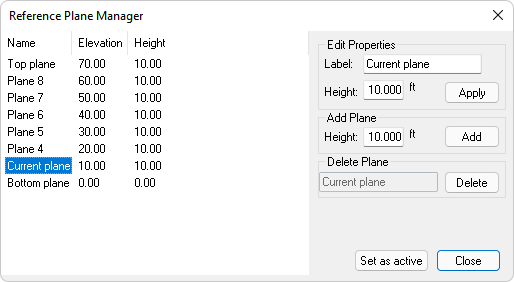
-
Click the Set as active button to make the selected plane the active plane.
-
Click on the File tab to open the File menu and choose Import. Alternatively, you can go to Loading>Import Loads and click on the Import from XLS File  icon.
icon.
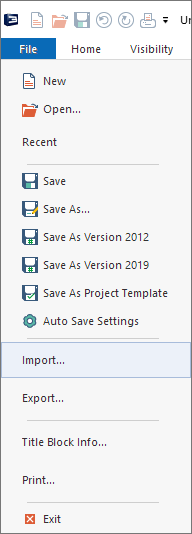
An Import panel opens.
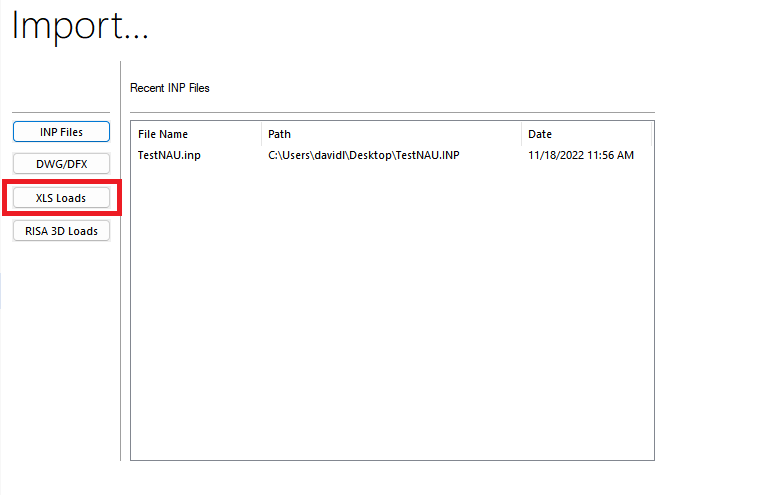
-
Click on XLS Loads.
An XLS Import Wizard opens.
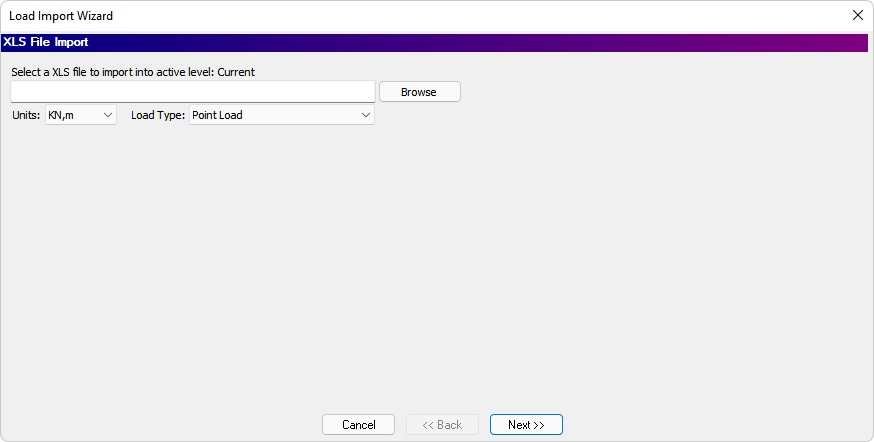
-
Browse to where the XLS file is and select it.
Use the XLS File Format Mapping Rules to determine what the units and the load type is for the XLS file you have chosen.
-
Click the Units arrow and choose the type of units you are importing.
-
Click the Load Type arrow and choose the type of load you are importing (Line Load or Point Load).
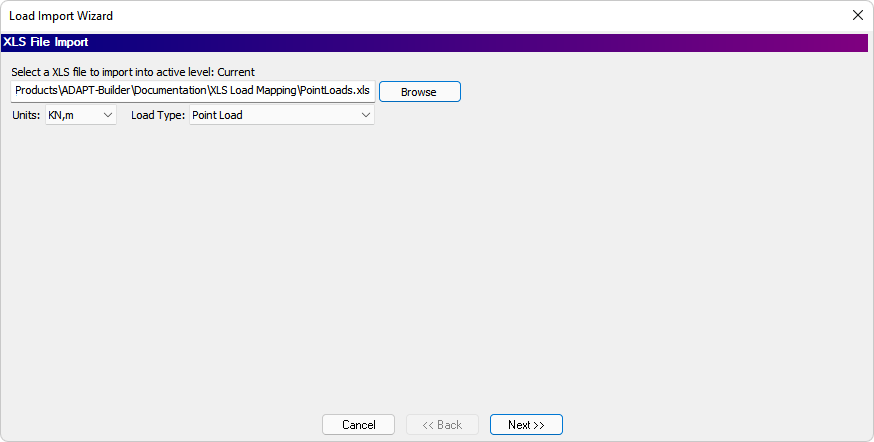
-
Click Next.
A Data Mapping and Preview list displays.
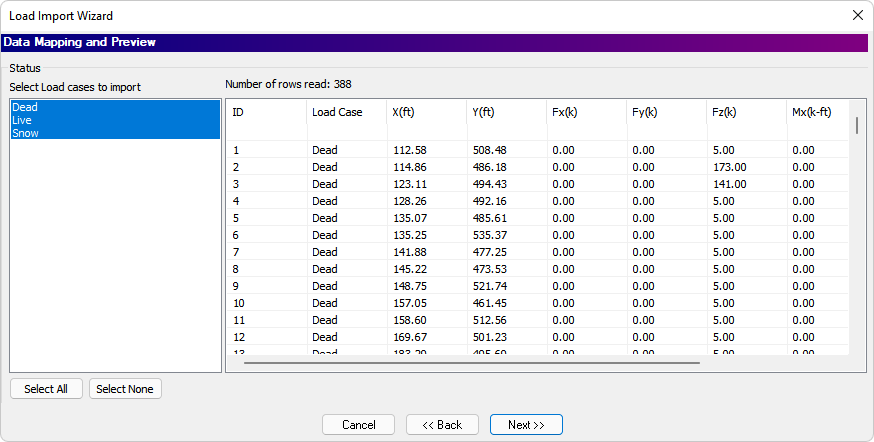
-
Review the mappings.
If the data appears to be correct, make sure the load cases you want to import in the Select load cases to import pane of the Load Import Wizard are selected (highlighted in blue) and click Next.
If the data appears to be incorrect, click Cancel, fix the issues in the XLS file, and then start the import again.
-
A Load Case Mapping list displays.
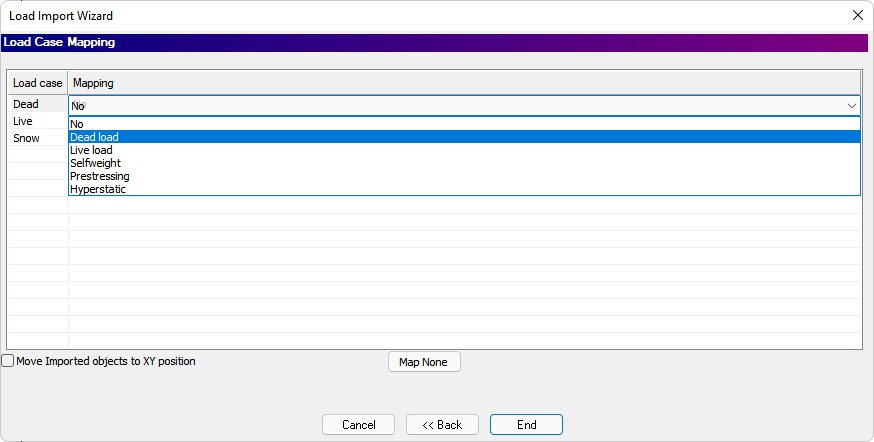
The Mapping option lets you map (assign) imported loads to the load cases that already exist in your ADAPT-Builder model. The mapping list includes the various load cases that are in your current model. For example, if we set the mapping option to Dead Load, the imported load case is imported as 'Dead Load' and no additional load cases are created; if it is set to NO (Map None), the program adds load case "Dead" and assigns it to the imported load.
-
Do one of the following, based on whether or not you want to map load cases.
-
Map load cases:
-
Click the Mapping arrow and select the load case from the model you want the load case to map to.
-
Repeat this step for each load case.
-
Do not map load cases:
-
Click the Map None button
-
(Optional) Check the Move Imported Objects to XY position checkbox, only if you want to do so in the model you are importing into.
Note: The Move Imported Objects to XY position option should be checked if importing to an existing model where the model origin is different than the origin for the coordinates in the XLS file. The program prompts you to click two points. The first is the base point for the move function, and the second is the end point for the move. Once the end point is entered, the program moves the imported loads to their new position.
-
Click End to finish the import.
XLS File Format Mapping Rules
The mapping of the data in your XLS file to ADAPT parameters depends on the format you are using; Point Load or Line Load. Regardless of which format is used, the first row is always reserved as the Header row, used to distinguish column headings.
Point Load Format
When Point Load format is selected, the program reads columns A through I and maps the data as follows:
|
Column A
|
Load case name
|
no units
|
| Column B |
X coordinate
|
m, ft or cm
|
| Column C |
Y coordinate
|
m, ft or cm
|
| Column D |
Fx
|
kN, k, T
|
| Column E |
Fy
|
kN, k, T
|
| Column F |
Fz
|
kN, k, T
|
| Column G |
Mxx
|
kN-m, k-ft, T-cm
|
| Column H |
Myy
|
kN-m, k-ft, T-cm
|
| Column I |
Mzz
|
kN-m, k-ft, T-cm
|
An example of the format for point loads in the XLS file is shown below:

Line Load Format
When Line Load format is selected, the program reads columns A through K and maps the data as follows
|
Column A
|
Load case name
|
no units
|
| Column B |
X1 coordinate
|
m, ft or cm
|
| Column C |
Y1 coordinate
|
m, ft or cm
|
| Column D |
X2 coordinate
|
m, ft or cm
|
| Column E |
Y2 coordinate
|
m, ft or cm
|
| Column F |
Fx1
|
kN, k, T
|
|
Column G
|
Fx2
|
kN, k, T
|
|
Column H
|
Fy1
|
kN, k, T
|
| Column I |
Fy2 |
kN, k, T
|
|
Column J
|
Fz1 |
kN, k, T
|
|
Column K
|
Fz2
|
kN, k, T
|
|
Column L
|
Mxx1
|
kN-m, k-ft, T-cm
|
|
Column M
|
Mxx2
|
kN-m, k-ft, T-cm
|
|
Column N
|
Myy1
|
kN-m, k-ft, T-cm
|
|
Column O
|
Myy1
|
kN-m, k-ft, T-cm
|
|
Column P
|
Mzz1
|
kN-m, k-ft, T-cm
|
|
ColumnQ
|
Mzz2
|
kN-m, k-ft, T-cm
|
An example of the format for line loads in the XLS files is shown below:

![]() icon to open the Reference Plane Manager.
icon to open the Reference Plane Manager.
 icon.
icon.






